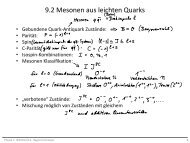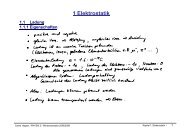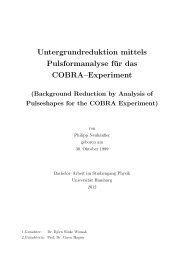Setup of a Drift Tube Muon Tracker and Calibration of Muon ...
Setup of a Drift Tube Muon Tracker and Calibration of Muon ...
Setup of a Drift Tube Muon Tracker and Calibration of Muon ...
Create successful ePaper yourself
Turn your PDF publications into a flip-book with our unique Google optimized e-Paper software.
Chapter 5CMT for BorexinoAs described in Chapter 4.3, uncorrelated cosmogenic induced background dominatesthe energy range between 1 <strong>and</strong> 2 MeV in Borexino. This is exactly the energyrange <strong>of</strong> CNO <strong>and</strong> pep neutrinos. In order to detect these neutrinos it is thus necessaryto underst<strong>and</strong> well the effects <strong>of</strong> muons crossing the detector <strong>and</strong> to find aneffective method to suppress the background.Identifying cosmogenic background events is not trivial since the actual backgroundsignal is not correlated to the crossing muon. Thus a simple muon veto isinsufficient. Instead, a three-fold coincidence <strong>of</strong> a crossing muon, a neutron capture<strong>and</strong> the delayed radioactive decay is used to reduce the cosmogenic background.The produced cosmogenic radionuclide is expected to be within the intersection <strong>of</strong>a cylinder around the initiating muon track <strong>and</strong> a sphere around the captured neutron.The affected volume can then be taken from the fiducial volume for a timeperiod <strong>of</strong> a few half-lives [72]. However, with more than 4000 muons crossing thedetector each day resulting in approximately 25 11 C decays, this could quickly leadto a large part <strong>of</strong> the fiducial volume blinded. Therefore the coordinates <strong>of</strong> the muontrack need to be known with a high precision to apply this cut. In Borexino, tracksare reconstructed from the time <strong>and</strong> pulse shape information from the PMTs whena muon crosses the detector (cf. Section 4.3.4). This method allows to reconstructtracks with a resolution <strong>of</strong> approximately 50 cm.An exact determination <strong>of</strong> the resolution <strong>of</strong> the Borexino muon tracking is hencea key prerequisite for keeping the vetoed volume small. The angular resolution hasbeen estimated before by a comparison <strong>of</strong> the angular muon distribution to the datacollected at LNGS by the MACRO detector [70]. However, for an exact determination<strong>of</strong> the resolution on an event by event basis, the true coordinates <strong>of</strong> the passingmuon have to be known. The CMT presented in Chapter 3 is capable <strong>of</strong> reconstructionmuon tracks with a precision close to their true coordinates. Operating theCMT together next to the Borexino experiment allows to collect a sample <strong>of</strong> cosmicmuons that pass both detectors. This sample can thus be used as a reference fordetermining the resolution <strong>of</strong> the Borexino tracking.This chapter describes the setup <strong>of</strong> the CMT at the LNGS laboratory. It is nowused to sample those cosmic muons crossing both the CMT <strong>and</strong> Borexino. Thus,some muon tracks will be known with high precision <strong>and</strong> can then be compared tothe Borexino reconstruction allowing to test the quality <strong>and</strong> the efficiency <strong>of</strong> theBorexino track reconstruction. Possible systematic errors can be identified <strong>and</strong> thus69





